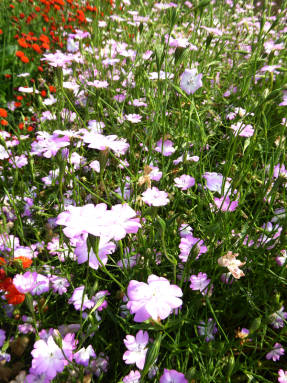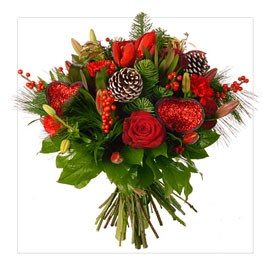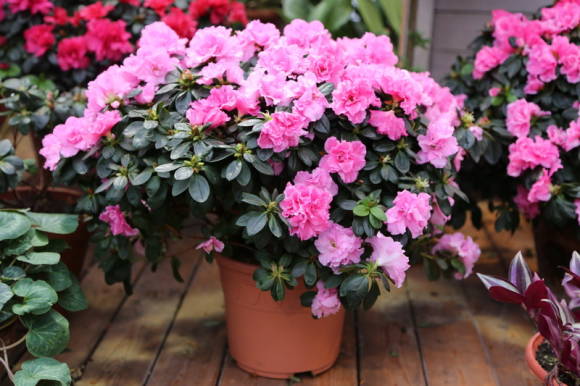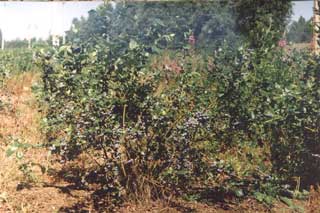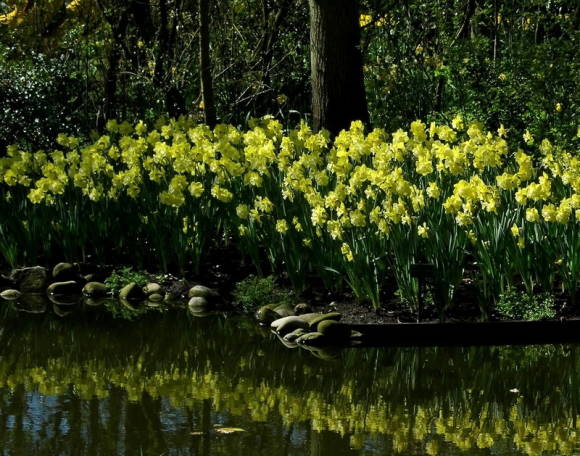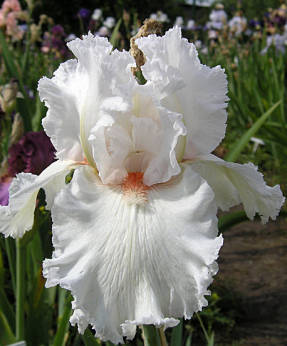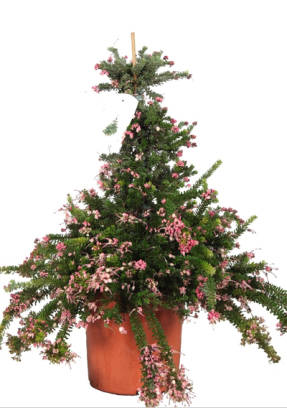Felt cherries are mainly grown in the Far East, China and Korea. Quite often, it is found in amateur gardens in Siberia and the Urals. Those who grow it find it difficult to recognize the well-known cherry in it.
 |  |
It is a shrub plant up to 3 m high, with highly spreading branches. But some gardeners form it in the form of a small tree, cleaning the bole and cutting off all the branches to a height of 60 cm. The branches are erect, brittle, grayish-brown, with light lenticels. Young shoots are greenish, with brown tomentose pubescence.
Felt cherry does not form root shoots. Felt cherry leaves are small, with short petioles. They are densely covered with short hairs. Felt cherry is a frost-hardy plant, but it is susceptible to drying out of tissues in the zone of the root collar (see below).
Felt cherry blossoms profusely and earlier than all other fruit crops. The flowers are white or light pink, with a very short stalk. At the time of flowering, the entire tree from the very base to the crown is covered with flowers and looks like a huge bouquet. The flowers are quite resistant to spring frosts.
In summer, the tree is covered with garlands of shiny fruits, which, like sea buckthorn, densely cover the branches and stay on the bush for a long time. The mass of fruits in most varieties is 2–2.5 g, in some varieties it reaches 4 g. Their color is from pale pink to dark red, the taste is from fresh to sweet-sour, very pleasant. The pulp of the fruit is juicy and tender.
Felt cherry begins to bear fruit early. Grafted annual plants yield a harvest within a year. Seedlings begin to bear fruit in the third or fourth year. Felt cherry is mostly self-fertile, that is, cross-pollination with other plants is necessary for fruit formation.
Felt cherry varieties
The varietal composition of the felt cherry is not rich, because its selection is carried out mainly in the Far East. In addition to seedlings grown from seeds, the following varieties are found in amateur gardens:
- Cupid... Bushes vigorous, spreading, winter-hardy. The fruits are rather large, dark red, sour-sweet. Ripen in the second decade of July.
- Delight... Medium ripening. The fruits are oval, dark burgundy, the flesh is red and dense. The variety is fruitful.
- Children - a variety of early ripening. The fruits are wide-round, dark pink, the flesh is red, dense. The yield is high.
- Twinkle... Bushes of medium size, relatively winter hardy. The fruits are quite large, red, very tasty. Ripen at the end of July. The variety is very productive.
- Dark girl... Bushes of medium size, winter hardy. Fruits are medium, almost black in color. The pulp is dark red, sour-sweet. The fruits ripen at the end of July.
- Khabarovsk... Bushes are medium in size. The fruits are quite large, pleasant to the taste. Fruiting is abundant and regular.
- Anniversary - a variety of early ripening. Fruits are oval, maroon. The yield is high.
Felt cherry propagation
Felt cherries are propagated by seeds, layering, green cuttings, grafts.
When propagated by seeds, the felt cherry retains the properties of its parental forms. When sowing in spring, seeds are preliminarily stratified in wet sand 90–100 days before sowing. You can sow them in the fall, 1.5 months before the soil freezes. When the seedlings have 3-5 leaves, they should be thinned out at a distance of 5-7 cm from each other.
Cherry also reproduces well with horizontal layering. To do this, in the early spring around the bush, grooves with a depth of 6–8 cm are made in the form of radial rays, 1–2-year-old branches are laid out and pinned with hooks in them. Vertical shoots grow from the buds of the bent branches. When they reach a height of 15 cm, their bases are covered with earth to form roots. In the fall, the layers are cut off and cut into seedlings.
Felt cherry is propagated by summer budding and grafting.At the same time, Ussuri plum or sandy cherry can be used as a stock.
Growing felt cherries

Landing... For planting felt cherries, the highest places should be allocated, protected from cold winds. She absolutely does not tolerate shading. Grows well on southern slopes with loamy, sandy loam, well-drained soils with a neutral reaction. Therefore, acidic soil must be limed.
Excess moisture adversely affects the growth, fruiting and overwintering of felt cherries, which often leads to the death of bushes. In such areas, it is advisable to plant felt cherries on hills or make high ridges for it.
The best time for planting seedlings is spring, although you can plant it in autumn. For better pollination on the site, it is necessary to plant either several seedlings, or 2-3 varieties of felt cherries. They are planted at a distance of 2.0-2.5 m from each other in planting holes measuring 50x50x50 cm.
The top layer of soil is poured into them, to which 3 buckets of compost, 3 cups of ash, 0.5 cups of superphosphate and 1–2 cups of lime are added, and everything is mixed well. On clay soil, it is imperative to add 1 bucket of coarse river sand to the pit.
Before planting, the root system of the plant must be cut to 20–25 cm and lowered into a clay mash. Young plants before planting are pruned to half the annual growth, which ensures good plant survival.
When planting, the root collar must not be buried; it should be 2-3 cm above the soil surface. After planting, the soil must be mulched. Felt cherry reacts painfully to deep digging of the soil; shallow loosening and mulching of the soil is preferable for it.
Pruning and shaping... Felt cherries need to be shaped. If you want the side branches to extend as low as possible from the main trunk, for seedlings with a growth of 40 cm, you need to pinch the tops.
When the growth of annual shoots is delayed in autumn, they must be pinched 3 weeks before frost, which sharply increases the winter hardiness of young plants.
In adult plants, in the spring, before bud break, sanitary pruning is carried out if necessary, cutting out diseased, broken and weakened branches, and after 5-6 years, rejuvenating pruning is done, which consists in the annual removal of one or two old branches. This will extend the period of the productive state of plants up to 12-15 years of age.

In very thickened plants in early spring, most of the shoots should be cut almost to the base. Many shoots grow from the remaining buds. Of these, only the strongest are left to form the crown. After severe damage or rejuvenating pruning, felt cherry recovers quickly.
Plant protection... Ripe felt cherry fruits remain on the branches for a long time and do not crumble. And only overripe fruits are sometimes affected by wet rot. But at this time, birds cause great damage to the cherry crop, so the crop must be protected.
Felt cherry is relatively resistant to diseases and pests. It is even resistant to coccomycosis, which is very difficult to fight in hobby gardens. Nevertheless, it is desirable to spray it in early spring, before bud break, with a 1% solution of copper sulfate or a little later in the "green cone" phase with a 3% solution of Bordeaux liquid.
Briefly about damping
All varieties of felt cherries, plums and plum-cherry hybrids are not resistant to damping, which often leads to the death of plants. This is one of the types of winter damage in which the bark and cambium die off at the base of the tree. At the same time, the wood, as a rule, remains healthy, there is no growth, abundant growth appears around the tree.
The reason for the damping out is the prolonged exposure of the plant to a temperature of about zero degrees, which is created near the soil surface under a thick layer of loose snow. This is often the case in areas with a sharp transition from thaw to frost, as well as on heavy, waterlogged soils, especially with early snowfall on non-frozen ground.
To protect it from damping, it is necessary to shovel the snow from the base of the bush at the beginning of winter or pierce it with a stake in several places to freeze the soil near the trunk. This technique must be repeated 2-3 times.
Another way to combat damping is to compact the snow by trampling on the near-trunk circles, the diameter of which should not be less than the projection of the crown of the tree. Compaction begins when the snow cover is 15–20 cm thick, and the subsequent ones after the next heavy snowfall or blizzard. Compacted snow contributes to the rapid freezing of the soil.
"Ural gardener", No. 21, 2020
